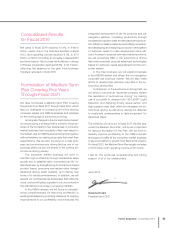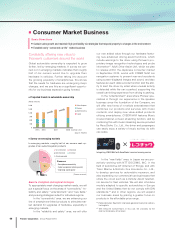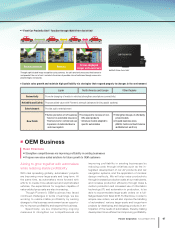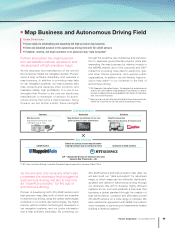Pioneer 2016 Annual Report Download - page 14
Download and view the complete annual report
Please find page 14 of the 2016 Pioneer annual report below. You can navigate through the pages in the report by either clicking on the pages listed below, or by using the keyword search tool below to find specific information within the annual report.
Autonomous driving is being developed for the pur-
pose of reducing traffic accidents caused by human
errors. For this reason driver monitoring is one of the
essential core technologies toward the realization of
autonomous driving.
Driver monitoring is also expected to make the
environment in vehicles more comfortable. This will
make it easier for on-board systems to anticipate the
driver’s interest, making it possible to provide contents
with more optimal timing and by more optimal means.
Pioneer’s development of vital sensors include
camera sensors that detect the driver’s eye gaze,
facial direction, and posture; steering wheel sensors
to track the driver’s heart rate; and seat sensors to
monitor the driver’s pulse rate.
Driver Monitoring
Driver monitoring is a technology that uses a vari-
ety of vital sensors to detect the driver’s biological
information to estimate the driver’s physical con-
dition. This is an indispensable technology for the
realization of autonomous driving, and has been a
focus of much attention in recent years. Pioneer’s
research and development aims to provide a full line
of technologies needed for driver monitoring, from
sensors to applications.
Autonomous cars will start from partially auton-
omous driving to realize fully autonomous driving. In
partially autonomous driving, it is essential to have
a function that determines in advance whether the
driver is in adequate condition to drive when switch-
ing from autonomous driving to manual driving.
Research and Development
Pioneer’s research and development mainly anticipates the future of the Car Electronics business. In ad-
dition to our traditional strengths in optics, signal processing, information processing, and systematization
through applying such capabilities as device development, we are developing new hardware technologies
for the future. These technologies cover areas including various sensing technologies, network services,
enhancement of map data precision, driver monitoring, and human machine interface (HMI), to grow the
business through the promotion and development of the coming age of autonomous driving.
We are also proactively conducting research and development in the areas of medical and health
care-related devices and OLED lighting, which we are cultivating as potential new core businesses.
Furthermore, we are undertaking joint research with universities, public research institutions, and
other private companies, in pursuit of realizing innovation and accelerated research and development.
Algorithm for improving and maintaining driver’s physical condition
Changes in heart rate, autonomic
nervous system, etc.
Adjustment for individual differences
Vehicle information
Driver
Improve and maintain driver’s
physical condition
Estimate driver’s
physical condition
Vital sensors
Stimuli through sounds,
vibrations, etc.
Drowsiness/Fatigue/Tension
Detection of driver’s
biological information
12 Pioneer Corporation Annual Report 2016
























